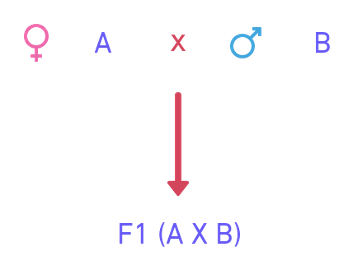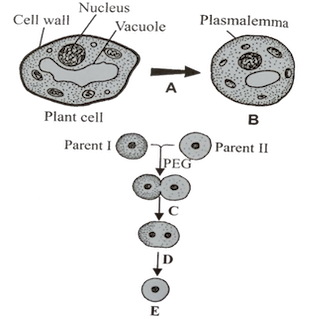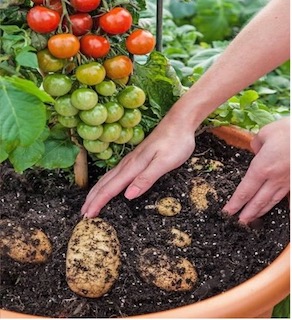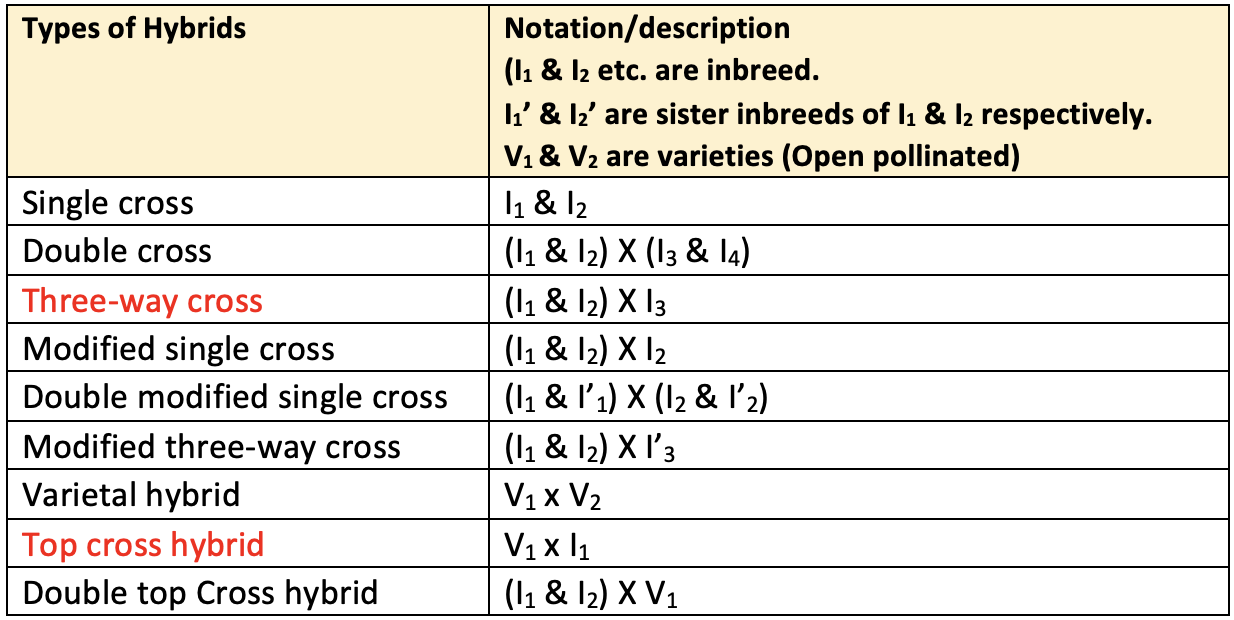🙅🏼♂️ Hybrids
Hybridization, Emasculation, Pollination, Synthetic, Composite
Hybridization
- The mating or Crossing of two plants or lines of dissimilar genotype is known as hybridization. In plants, crossing is done by placing pollen grains from one genotype i.e. male parent, on the stigma of flowers of other genotype i.e. female parent. It is essential to prevent self-pollination as well as chance cross-pollination in the flowers of female parent used for crossing.
- The seeds as well as progenies resulting from hybridization are called hybrid or F1.
- The progeny of F1 obtained from selfing or intermating of F1 plants, and the subsequent generations are known as segregating generations.
- The term ‘Cross’ is often used to denote the products of hybridization i.e. F1 & segregating generations.
Metaxenia: The effect of pollen on the maternal tissue of the fruit i.e. the pollination effect on the same generation is called Metaxenia.- Sexuality: Reproductive parts of the plant were firstly reported by N. Grew in 1682.
- Sexual reproduction in the plant was first time described by R. Camerarius in 1694
Camerariusalso produced a hybrid between two different plant species, for the first time.- However, in 1717,
T. Fairchildproduced a hybrid having characteristics of both parents popularly called “Fair child’s Sweet William” or “Fairchild’s mule”. - The mammalian egg was discovered by
Von Baerin 1928. - Today hybridization is the most common method of crop improvement.
- Objective: The main objective of hybridization is to create genetic variation.
- The aim of hybridization may be transfer of one or few qualitative characters, improvement of one or more qualitative character, or use of the F1 as a hybrid variety.
- Combination Breeding: The transfer of one or more characters from other varieties into a single variety is known as combination breeding. Development of disease resistance is the example of combination breeding.
- Transgressive Breeding: Transgressive segregation means production of plants in F2 generation which are superior to both the parents for one or more characters. The breeding for improving yield or its contributing characters through transgressive segregation is called Transgressive breeding.
- Hybrid Varieties: In most self-pollinated crops, F1 is more vigorous and higher yielding than the parents. F1 is used directly as a variety.
Types of hybridization
👉🏻 On the basis of taxonomic relationships of the two parents, hybridization is of two types. Intervarietal & Distant hybridization.
Intervarietal hybridization
- Parents are of the same species i.e. maybe two strains, varieties or races of the same species. This is also known as intraspecific hybridization.
- Infra - specific means within species.
- Inter - specific means two different species.
- Intervarietal means two different varieties (like inter - cast marriage).
- Intervarietal hybridization is the most commonly used in the crop improvement programme.
- Intervarietal crosses may be simple or complex:
- Simple cross: Here two parents are crossed to produce the F1. F1 is selfed to produce F2 or is used in a backcross programme E.g.

- Complex cross: Here > 2 parents (more than two parents) are crossed to produce F1 which is used to Produce or is used in a backcross programme. Such cross is used in converging the genes i.e. bringing the genes from several parents into a single hybrid. Therefore complex cross is also called
Convergent Cross. - When F1 from a simple cross is crossed to a third parent, it is called
Three Way Crossor F1 top cross. - When F1s from two single crossed are mated together, the cross is called
Double Cross.
- Simple cross: Here two parents are crossed to produce the F1. F1 is selfed to produce F2 or is used in a backcross programme E.g.
Distant hybridization
- Here crosses are made between different species of the same genus or of different genera.
- Interspecific cross means the cross, between two different species of the same genus E.g.
Gossypium arborium x Gossypium hirsutum.
- Intergeneric cross means the cross between two different genera. E.g.
Triticum turgicium x Secale cereale (Rye) → Triticale hexaploide
- Generally distant hybridization is made to transfer one or few simply inherited characters like disease resistance to a crop species.
👉🏻 Procedure of Hybridization: There are 7 steps involved in hybridization:
- Choice of parents
- Evaluation of parents
- Emasculation
- Bagging
- Tagging
- Pollination
- Harvesting and storage of F1 seed
Emasculation
- Removal of stamens or anthers or killing the pollen grains of a flower without affecting the female reproductive organs is known as emasculation.
- Emasculation = E (means removal) + masculation (means masculine)
- Emasculation is the removal of masculinity.
- Purpose of Emasculation: To prevent self-fertilization in the flowers of the female parent.
- In dioecious plants, male plants are removed.
- In monoecious plants, male Flowers (in castor) or male inflorescences (in maize) are removed.
- Emasculation is essential in
bisexual flowers.
Techniques
- a) Hand emasculation: Hand emasculation is generally done
- in the evening between 4 pm to 6 pm.
- one day before the anthers are expected to dehisce or mature, and
- the stigma is like to become fully receptive.
- b) Suction method: useful in species with small flowers. Emasculation is done in the morning just before or immediately after opening of the flower. Here suction hose is used to suck the anthers.
- c) Hot water Emasculation: In jowar (S. bicolor) treatment of flower with water at 42-48° C for 10 minutes and in rice (O. sativa), 10 minutes treatment with water at 40-44°C, kill the pollen grains. Hot water treatment is given before anther’s dehiscence and prior to opening of flowers.
- d) Alcohol treatment: It is not a common method. In Sweet clover, immersion of the inflorescence in 57% alcohol for 10 seconds was highly effective.
- e) Cold treatment: In
ricecold water treatment at 0-6° C kills the pollen grains without affecting gynoecium. Exposure ofwheatplant at 0-2° C for 15-24 hours kills the pollen grains. - f) Genetic emasculation: Genetic or cytoplasmic male sterility may be used.
Tagging
- A tag having the following information written with a carbon pencil is attached:
- Date of emasculation
- Date of pollination rent
- Name of the male & female parents. The name of the female parent is written first. E.g. A x B. Here A is female parent and B is the male parent.
Pollination
- To bring about fertilization, mature, freshly and viable pollen should be placed on a receptive stigma.
- The pollination procedure consists of collecting pollens from freshly dehisced anther and dusting these pollens on the stigma of the emasculated flowers.
- Production of hybrid seed by hand pollination is commercially feasible in crops like tomato, brinjal & tobacco because each fruit produces a large no. of seeds.
- Cornerstones of hybridization
- Prevention of self-pollination in the flowers of parent is achieved through emasculation of the flowers.
- Prevention of pollination of the flowers of female parent by pollen from undefined sources is achieved through bagging of flowers.
- Ensuring pollination by the selected male parent i.e. prevention of contamination of the pollen used for pollination in a crop like maize is achieved through Hand pollination (Bagging of the male inflorescence)
Somatic Hybridization
- Development of hybrid plants through the
fusion of somatic protoplastsof two different plant species/varieties is called somatic hybridization. - This is a non-conventional genetic procedure involving fusion between isolated protoplast under in vitro condition and subsequent development of their product (heterokaryon) to a hybrid plant.

Example: Pomato = Potato + Tomato

The breeding methods commonly used in cross-pollinated crops
Population Improvement
- Population improvement was the earliest breeding method applied to cross-pollinated crops.
- Cross pollinated crops generally show moderate to severe inbreeding depression. Therefore, inbreeding must be avoided or kept to minimum in cross pollinated species.
- In cross pollinated species the genotype of the individual plants is generally of little importance particularly in population improvement. Here value of population is determined by the frequency of desirable genes or alleles in the population as a whole.
- Population improvement methods are grouped into two general classes.
- Without progeny testing: Plants are selected on the basis of their Phenotype and no progeny testing is carried out e.g. mass selection.
- With progeny testing: Plants are initially selected on the basis of their phenotype but final selection is one on progeny testing i.e. progeny selection (ear to row method) & recurrent selection
- Mass Selection: Oldest breeding method for cross pollinated crops. Here a no. of plants are selected on the basis of their phenotypes and open-pollinated seeds from them are bulked together to grow the next generation. No progeny test is conducted. Mass selection is based on the maternal parent only and there is no control on the pollen (♂) parent. The same mass selection of self-pollinated crops is applied to the cross pollinated crops.
- Progeny Selection: The Simplest form of progeny selection is
Ear to Row Methodwhich has been extensively used in maize. This method was developed byHopkinsin 1908. Here a no. of plants (50-100) are selected on the basis of their superior phenotypes and are allowed to open pollinate. Seeds from individual plants are harvested separately. A single-row of 10-50 plants i.e. progeny row is grown from each selected plant. The progeny rows are evaluated for desirable characters and superior progenies are identified. Several phenotypically superior plants are selected and are allowed to open pollinate. Small progeny rows (10-15 plants) are grown from the selected plants and the process is repeated one or more times and then yield trials are done. - Recurrent Selection (RS): The idea of recurrent selection was first suggested by Hayes and Garber in 1919 and independently by East & Jones in 1920. Hull suggested that recurrent selection may be useful in improving specific combining ability.
- In cross-pollinated population, a no. of plants are selected on the basis of phenotype or progeny test and are self-pollinated. The progenies obtained are intercrossed in all possible combinations by hand. Equal amount of seed from each cross is composited to produce next generation.
- General combining ability (GCA): GCA is the average performance of a strain in a series of cross combinations. GCA is estimated from the performance of F1s from the crosses.
- Specific combining Ability (SCA): SCA is the deviation in performance of a cross combination from that predicted on the basis of GCAs of the parents involved in the cross.
- Recurrent selection is based on progeny tests and rigid control on pollination. The seeds for progeny tests are obtained:
- by selling (i.e. Simple recurrent selection) or by crossing
- to a tester with broad genetic base (i.e. recurrent selection for GCA)
- or to an inbred (i.e. recurrent selection for SCA)
- In Reciprocal Recurrent Selection (RRS) two sources of populations are used as testers for each other.
- Theoretically, in almost all practical situations, Reciprocal Recurrent selection (RRS) may be expected to be superior to recurrent selection for GCA (RSGCA) and Recurrent selection for SCA (RSSCA).
Hybrids
- Hybrid varieties are the first generations (F1) from crosses between two purelines, inbreeds, open - pollinated varieties, clones or other populations that are genetically dissimilar.
- Inbred: An inbred is a nearly
homozygousline developed by continued inbreeding usually selfing, accompanied by selection in a cross-pollinated crop. - Sister inbred: The inbreds which have 50% or more genetic commonality.
- Single cross: When two inbreds, A & B are crossed to produce the hybrid (A x B), it is called single cross.
- Double cross: When two single crosses i.e. (A x B) and (C x D) are crossed to produce the hybrid (A x B) x (C x D); it is called double cross. It means double cross involves four inbreeds crosses. i.e., A, B, C, D which are first crossed to produce two single cross.
- Top cross/Inbreed-variety cross: When an
inbreedis crossed with anopen-pollinated variety, it is known as top cross or inbreed variety cross. - The purpose of top cross is to estimate GCA (general combining ability), of the plants or lines crossed with open pollinated variety. When the cross is made to assess combining ability, it is known as
test cross. The common parent used in test cross is known as tester and the progenies obtained from these crosses are called test cross progenies. - Poly cross: Means open-pollination (Assumed to be random mating) in isolation among a number of selected genotypes.
- Polycross is the progeny of a line produced through random pollination by a number of selected lines.
- Population cross/varietal cross: The cross between two open pollinated varieties is known as population cross or varietal cross.

- Hybrid varieties were first commercially exploited in maize. The greatest use of hybrid varieties has been made in maize.
- Four hybrids of maize i.e.,
Ganga 1,Ganga 101,Ranjit&Deccanwere released in 1961 in India. All were double crosses. Production of double cross in maize was first suggested byJones. Ganga Safed-2is a double top cross variety of maize.- In India first hybrid variety of Jowar (S. bicolor) was Coordinated Sorghum Hybrid
CSH 1(released in 1964) by using Cytoplasmic Genetic Male Sterility (CGMS) ofCombine Kafir 60as ♀ parent. - In India First hybrid variety of Pearl Millet (P. americanum) was Hybrid Bajra
HB 1(released in 1965 by using Cytoplasmic Genetic Male Sterility ofTift 23 A(Introduced from Tifton, Georgia, USA as ♀ parent). HB 1 is the Single Cross. - In India Hybrid Cotton is produced by hand pollination.
- Hybrid Cotton: India is the first country to exploit hybrid vigour commercially in cotton. All the hybrid varieties have been developed in the tetraploid cottons.
Gregg-99is a male sterile line used in cotton.H 4was the first hybrid variety of cotton developed by Gujarat Agriculture University (Surat station) and released in 1970.- Intraspecific Hybrid Cotton: by crossing two different strains of G. hirsutum i.e.,
G. hirsutum x G. hirsutum
- H4 (Hybrid-4)
- H6
- Godavari
- Interspecific Hybrid Cotton: by crossing one strain of G. hirsutum with a strain of G. barbadense. i.e.
G. hirsutum x G. barbadense
- Varalaxmi: Was the first interspecific hybrid variety (cotton) developed by University of Agricultural Sciences (Dharward Station) and released in 1972.
- Jaylaxmi
Hybrid Rice in India
- A Cytoplasmic Male Sterile (CMS) line of rice was first developed in 1972 by Athwal & Birmani by transferring the nuclear genotype of Indica rice variety Pankhari 203 into the cytoplasm of another indica variety TN-1.
- The CMS-WA (Wild Abortive) cytoplasm was identified. In a population of wild rice (O. sativa f. spontanea) in the year 1970 in China.
- The CMS-WA leads to pollen abortion and is presently used in 95% of the CMS lines used for hybrid rice production. First hybrid rice APHR-1 was released in 1994.
- Other hybrid rice varieties: APHR-2, MGR-1, KRH-1, CNHR-3, DRRH-1.
- A basmati hybrid rice named
Pusa Rice Hybrid 10(PRH-10) was developed at IARI, New Delhi. - Commercial hybrid varieties are either single crosses or double crosses. Single cross hybrid varieties are common in Pearl Millet, Sorghum, Cotton, Rice and in Maize (in U.S.A.).
- Double cross varieties are common in Maize in India.
- The largest number of hybrid varieties have been developed in
Pearl Millet & Sorghum(Maize stands second). - The predicted performance of any double cross is the average performance of the four non-parental single crosses involving the four parental inbreds e.g. performance of double cross (A x B) x (C x D) would be the average of performance of the single crosses A x C, A x D, B x C and B x D, since these single crosses are not involved in producing the concerned double cross. This method was developed by
Jenkins(1934). - Two requirements of commercial hybrid seed production:
- Easy emasculation of the ♀ parent.
- Effective pollen dispersal from ♂ parent to ensure a satisfactory seed set in ♀ parent.
- Hybrid seed may be produced by:
- Cytoplasmic Genetic Male Sterility (CGMS)
- Cytoplasmic Male Sterility (CMS)
- Genetic Male Sterility (GMS)
- Self-Incompatibility (SI)
- Manual Emasculation and/or Pollination
Synthetic Varieties
- Synthetic variety is produced by crossing in all combinations a number of lines that combine well with each other.
- Once synthesized, a synthetic is maintained by
open pollinationin isolation. - The lines used to produce a synthetic variety are
tested for combining abilitywith each other. Therefore, the yield of synthetic varieties can be predicted in advance. - GCA is generally estimated by top cross or poly cross test.
Composite Varieties
- Composite variety is produced by mixing seeds of several phenotypically outstanding lines and encouraging open-pollination to produce crosses in all combinations among the mixed lines.
- The lines used to produce a composite variety are
rarely tested for combining abilitywith each other. Therefore the yield of composite varieties cannot be predicted in advance. - Composites are more popular than the hybrid varities because the seeds produced by a composite variety
- Can be used again as seed for 3 to 4 years.
- Have negligible inbreeding effect
- Make varietal maintenance easy.
- The first six composite varieties in India were released in 1967:
- Six maize composites 👉🏻
Vijay,Kisan,Amber,Jawahar,Vikram&Sona
- Six maize composites 👉🏻
- Composite is often used as a synonym for synthetic but is not entirely accurate.
- Like synthetics, composites are commercial varieties and are maintained by open-pollination in isolation.

- Germplasm Complexes are produced by mixing seed from several lines or populations of diverse genetic origins.
- The objective of germplasm complexes is to serve as reservoirs of germplasm. Such complexes are experimental populations and not commercial varieties.
- The possibility of commercial utilization of synthetic varieties in maize was first suggested by Hayes & Garber in 1912.
- Synthetic varieties have been of great value in breeding of those cross pollinated crops where pollination control is difficult e.g. forage crops, many clonal crops like cacao, alfalfa, clovers etc. The programme at CIMMYT, Mexico & Pearl millet breeding Programme at ICRISAT, Hyderabad are based on synthetic varieties.
- The performance of synthetic 2 (Syn2) is expected to be lower than that of Syn1 due to decrease in heterozygosity due to random mating. However, there would be no further decline in subsequent generations produced by open-pollination (Syn3, Syn4 etc.) because the zygotic equilibrium for any gene is reached after one generation of random mating.
- The performance of synthetic varieties is usually lower than the best single or double cross hybrid because synthetics exploit only GCA while hybrid varieties exploit
both GCA & SCA(General Combining ability & Specific Combining ability).
Advantages of synthetic varieties:
- Synthetic varieties are practically feasible means of exploiting heterosis in species where pollination control is difficult.
- Seed production is simpler & cheaper.
- Farmer can save his own seed. Synthetics can be maintained for several years from open pollinated seed.
- Synthetics serve as good reservoirs of genetic variability.
- Synthetics may be expected to perform better than hybrids in a variable environment because synthetics have wide genetic base in comparison to that of hybrid varieties.
Multiline Varieties
- Multiline varieties are
mixtures of several pure linesof similar height, flowering & maturity dates, seed colour & agronomic characteristics but they have different genes for disease resistance. - The idea of multiline varieties was put forward by Jenson in 1952 for use in cereals.
Hybridization
- The mating or Crossing of two plants or lines of dissimilar genotype is known as hybridization. In plants, crossing is done by placing pollen grains from one genotype i.e. male parent, on the stigma of flowers of other genotype i.e. female parent. It is essential to prevent self-pollination as well as chance cross-pollination in the flowers of female parent used for crossing.
- The seeds as well as progenies resulting from hybridization are called hybrid or F1.
- The progeny of F1 obtained from selfing or intermating of F1 plants, and the subsequent generations are known as segregating generations.
- The term ‘Cross’ is often used to denote the products of hybridization i.e. F1 & segregating generations.
Metaxenia: The effect of pollen on the maternal tissue of the …
Become Successful With AgriDots
Learn the essential skills for getting a seat in the Exam with
🦄 You are a pro member!
Only use this page if purchasing a gift or enterprise account
Plan
₹
- Unlimited access to PRO courses
- Quizzes with hand-picked meme prizes
- Invite to private Discord chat
- Free Sticker emailed
Lifetime
₹
9,999
once
- All PRO-tier benefits
- Single payment, lifetime access
- 4,200 bonus xp points
- Next Level
T-shirt shipped worldwide

Yo! You just found a 20% discount using 👉 EASTEREGG

High-quality fitted cotton shirt produced by Next Level Apparel